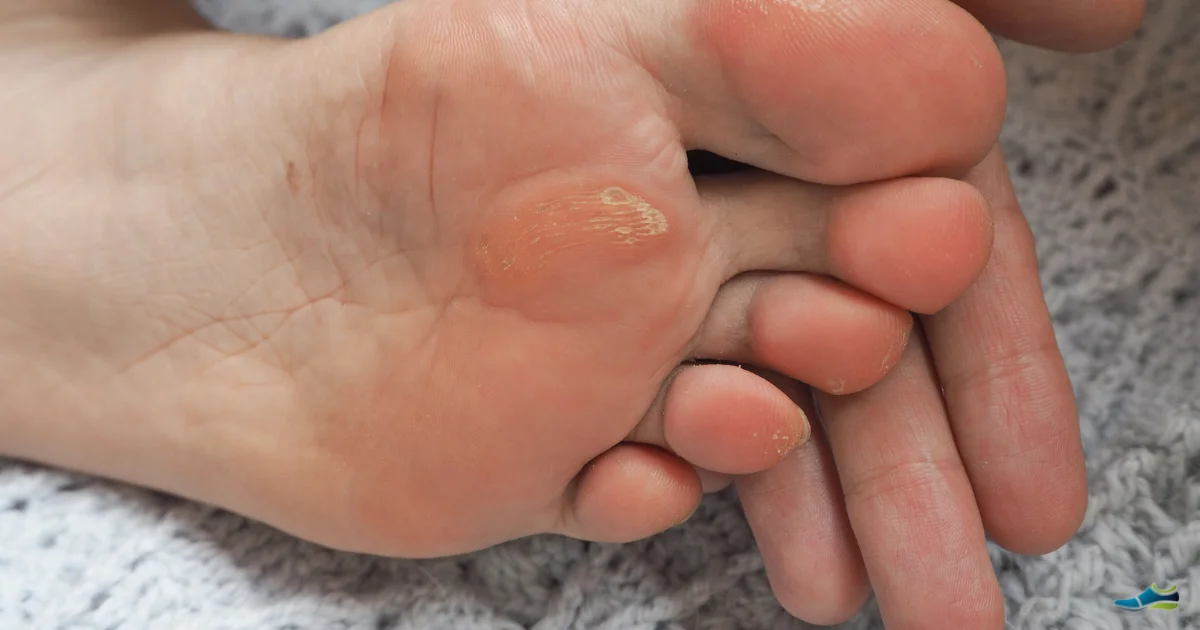Thick, hard skin building up under the ball of your foot or on your heels? That’s a callus — your body’s way of protecting itself from pressure and friction. The right footwear and a simple care routine can make them far less painful and far less frequent but because there are various causes of calluses on feet, there are various treatments too. Changing one single thing is unlikely to cure them.
💡 Quick Answers Available
Want the short version? Check out our Calluses Info Bytes for 20 fast answers to the most common calluses questions.
This guide covers causes, symptoms, treatment, prevention, and the shoe features that help.
What Are Calluses?
Calluses are areas of thickened skin that develop in response to repeated pressure or rubbing. They are usually larger and flatter than corns and commonly appear on the ball of the foot, the heel, or along the sides of the forefoot.
Causes and Risk Factors
- Shoes that are too tight, too loose, or too hard underfoot
- Narrow toe boxes concentrating pressure on the forefoot
- High heels shifting weight forward
- Long hours on hard floors, running or impact sports
- Foot mechanics: hammertoes, bunions, long second toe, flat feet or high arches
- Age‑related thinning of the fat pad under the forefoot/heel
Symptoms and How to Recognise Them
- Patch of thick, rough, yellowish skin
- Often painless at rest but tender with pressure or push‑off
- May crack at the heel (fissures) causing soreness or bleeding
- “Hot spots” under metatarsal heads that feel like walking on a pebble
How Footwear Plays a Role
Calluses form where shoes and ground forces overload the skin. Footwear that spreads pressure and reduces friction limits build‑up.
- Wide, deep toe box to stop pinch points
- Cushioned midsole + quality insole to soften impact
- Rocker or stiffer forefoot to reduce painful toe bend and push‑off load
- Softer linings to minimise rubbing along the sides
Treatment Options
At‑home care
- Soak feet in warm water 5–10 minutes
- Gently reduce thick skin with a pumice/foot file (never use a blade)
- Apply a urea / oil based moisturiser (10–25%) daily to soften skin
- Use felt/gel pads or metatarsal pads to offload sore spots
Footwear adjustments
- Switch to shoes with a roomy forefoot and better cushioning
- Add insoles with forefoot cushioning or a metatarsal dome (placed just behind the sore area)
- Limit high heels and very thin, hard soles
Professional care
- Podiatry debridement (safe removal of excess skin)
- Custom orthotics if mechanics are driving focal pressure
- Address underlying deformities (e.g., rigid hammertoes) if needed
Prevention Tips
- Rotate footwear; avoid wearing the same pair every day
- Use cushioned socks; avoid seam rub over pressure areas
- Keep skin supple with regular use of urea or oil based moisturiser
- Manage callus little and often (weekly light file) rather than rarely and aggressively
- Check in with a podiatrist if callus builds quickly or cracks recur
Best Shoes for Calluses
Prioritise:
- Wide/rounded toe box to reduce squeeze
- Forefoot cushioning (plus optional met pad) to spread load
- Rocker or stiffer forefoot for painful ball‑of‑foot calluses
- Supportive midsole/arch to balance pressure across the foot
Don’t forget that the causes of calluses on feet can be for several reasons, not just one.
When to See a Doctor or Podiatrist
- Persistent pain despite footwear and pad changes
- Heel fissures that crack/bleed or risk infection
- Diabetes, neuropathy, or poor circulation (higher complication risk)
- Rapid callus return suggesting a biomechanical driver
FAQs
Q: What’s the difference between a callus and a corn?
A: Calluses are larger, flatter areas of thick skin from pressure; corns are smaller with a hard centre, often on toe tops or between toes.
Q: Should I cut a callus off?
A: No blades. Use gentle filing after soaking, moisturise, and offload pressure. See a podiatrist for safe debridement.
Q: Do metatarsal pads really help?
A: Yes — placed just behind the sore spot, they lift and spread pressure away from the callus.
Q: Why do my calluses keep coming back?
A: The cause (pressure/friction) is still there. Fix fit and loading (wider toe box, cushioning, orthotics if needed) and maintenance becomes easier.
Related Reading
- Corns
- Metatarsalgia
- Wide Fit Shoe Buying Guide
Calluses are a pressure problem. Reduce the load, soften the skin, and keep up light regular care — your feet will feel smoother and more comfortable with every step.

